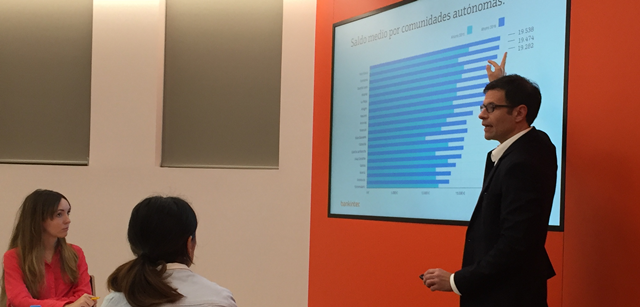
Most Spaniards put their digital savings toward travelling
Home-ownership comes in second for individuals, whose savings target for down payments to buy a home is over 32,000 EUR, according to the 2016 COINC Savings Report.
Customer savings in northern autonomous regions increased by approximately 4,000 EUR in 2016, compared to a yearly increase of less than 3,000 in the south, in line with income.
Saving up for a trip has become the primary goal of digital savings customers in Spain, according to the 2016 COINC Savings Report. This report is based on statistics collected from over 111,000 users of this fully digital financial services platform created by Bankinter.
COINC analysed the saving habits of customers with around 900 million EUR in total deposits on the portal for different savings goals that they set for themselves (eg, savings, travelling, wedding, electronics, buying a car, education, etc). This is the largest amount of money in savings analysed in Spain. The report provides a thorough overview of digital savings customers in Spain and their savings habits in terms of their own goals, ages, geographic locations and genders.
Overall, 53% of customers put their money in general savings. However, if we consider goals and uses that are not related to general savings, 21% of individuals put money away in this ‘digital piggy bank’ in order to pay for a big trip. This was also the case in 2015, according to the findings of the COINC Savings Report for that year. The average savings target set by savings customers to cover travel expenses is 10,800 EUR.
After travel expenses, purchasing a home is the second most popular use of their savings, since 20% of COINC users with specific savings goals on the platform chose this particular option as a top priority. In this case, however, the average amount customers aim to save triples to 32,900 EUR, since purchasing a home involves a much higher investment.
After travel and home purchases, 13% of all users aim to save money to buy a car or motorbike. Furthermore, ahead of saving for gifts or education, more users are saving to purchase electronics. More specifically, 8% of all COINC users (especially, young users) claim to save for this purpose.
There are substantial differences among individuals in their saving habits according to their ages. Spanish savers over the age of 35 managed to increase their wealth in 2016 by as much as 8% compared to the previous year, different from younger savers. This shows that, from this age on, there is a qualitative leap in the overall profile of savings customers in Spain, as they usually have higher incomes, more stability at work and in their personal lives, and thus, more eagerness and a greater ability to save money.
Adults aged between 45 and 49 have a higher ability to save, which grew by 8% from 2015 to 2016. Their savings averaged about 12,000 EUR. This amount is the same that Spaniards aged between 50 and 54 manage to keep in their digital piggy banks. Still, in this case, this age group saved 7% more during the same period of time.
In other age groups, savings continue to grow; however, they increased by much less. People aged between 35 and 39 put away an average 8,800 EUR in savings, up 3% from 2015. This growth rate is also apparent among those aged 55 to 59. However, there is a fundamental difference in that this age group manages to put away, on average, 13,000 EUR (4,200 more) in savings.
On the other hand, the savings of customers under the age of 30 fell between 4% and 35%. The younger they are, the less they save. These data, in part, underscore the economic gap between young people who entered the workforce after the 2008 financial crisis began and have yet to benefit from the path to recovery, and those who are older than 30 and were already active in the workforce.
There are also differences in savings habits between men and women. Under the age of 30, women have a higher ability to save than men. However, in the 30-40 age group, the tables turn, as men are seen to save more than women. This is, without a doubt, influenced by the fact that, on average, women’s salaries are lower men’s. Furthermore, men and women have different savings goals, with women showing more interest than men in travel, baby products, and fashion, while men are more interested in areas such as cars, motorbikes and electronics.
Moreover, the economic gap between customers living in northern and southern autonomous regions is still apparent. This is mainly due to per-capita income differences between these two regions in general. Autonomous regions like the Basque Country, Cantabria and Castile and Leon find themselves at the top of the ranking with the highest savings volume. Furthermore, they have also seen the average savings balance of their residents increase by around 4,000 EUR this year. Meanwhile, savings in other regions have increased by less than 3,000 EUR, with Extremadura, Murcia and Andalusia at the bottom end of the ranking.
COINC sees a 30% increase in customers and savings accounts
COINC (www.coinc.es) is Bankinter’s fully digital financial services platform that was launched in 2012. Its purpose is to help users achieve specific goals by making saving and managing costs and loans something easy and even fun. COINC ended 2016 with a 34% increase in customers, exceeding 111,000 customers. It also brought in 30% more deposits, accumulating over 1.3 billion EUR. 50% of COINC customers access the platform on their mobile devices.